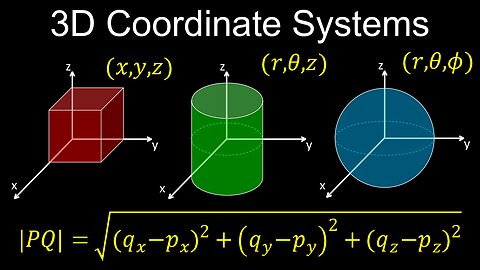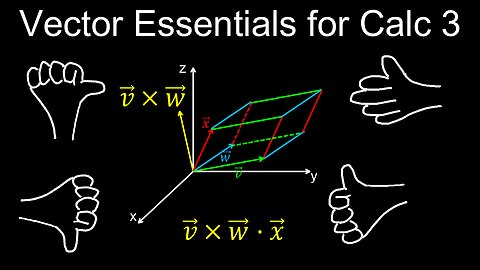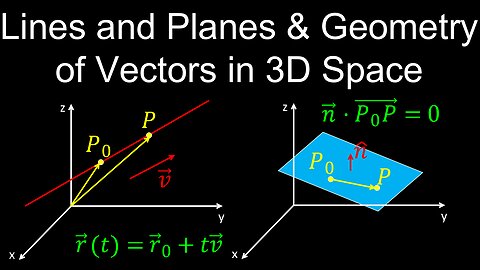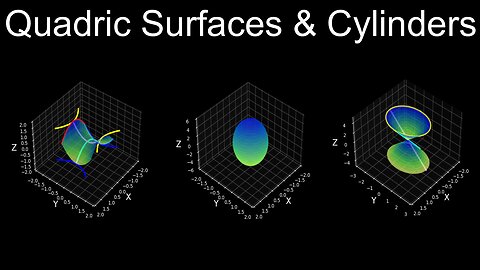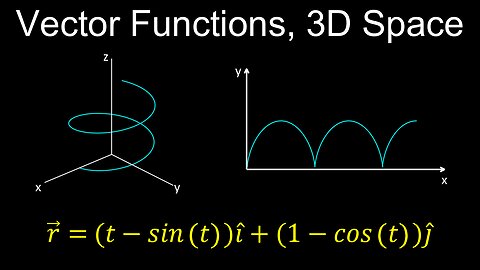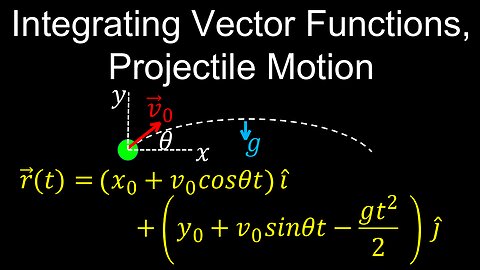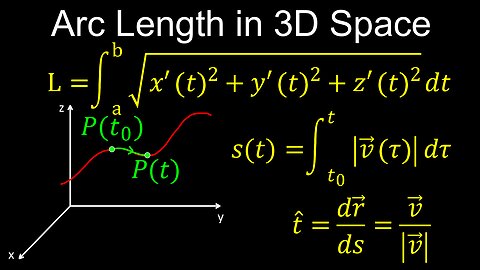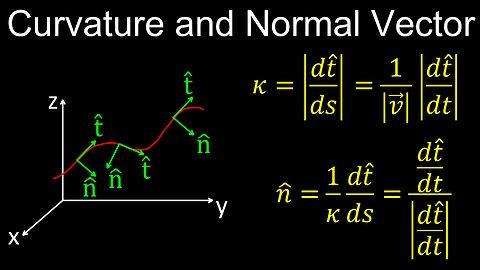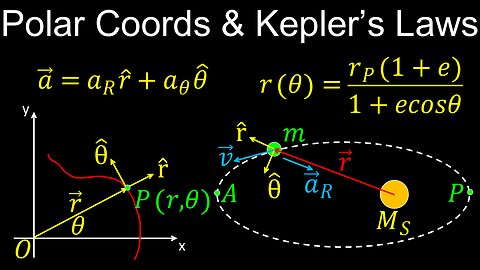-
3D Coordinate Systems, Distance and Spheres in Space - Calculus 3
 DrOfEngThis Calculus III video explains 3D coordinate systems, including rectangular (Cartesian) vs cylindrical vs spherical coordinates and how to visualize them, extending the Pythagorean theorem to compute distance in 3D space, representing spheres in 3D space, geometric interpretations of inequalities, and worked examples. 0:00 3D Cartesian coordinate system 5:23 Cartesian vs cylindrical vs spherical coordinate systems 8:53 Distance in 3D space 10:45 Spheres, standard representation99 views 1 comment
DrOfEngThis Calculus III video explains 3D coordinate systems, including rectangular (Cartesian) vs cylindrical vs spherical coordinates and how to visualize them, extending the Pythagorean theorem to compute distance in 3D space, representing spheres in 3D space, geometric interpretations of inequalities, and worked examples. 0:00 3D Cartesian coordinate system 5:23 Cartesian vs cylindrical vs spherical coordinate systems 8:53 Distance in 3D space 10:45 Spheres, standard representation99 views 1 comment -
Vector Essentials for Calc 3, Algebra - Calculus 3
 DrOfEngThis video covers essential vector topics for Calculus 3, including vectors vs scalars and basic notation, position vectors, vector components and magnitude, vector addition and scalar multiplication, properties of vector operations, subtraction, unit vectors and normalization, dot product, orthogonality, angle between vectors and projection, vector cross product, determinant form and properties, scalar triple product and determinant form, and worked examples. 0:00 Vectors vs scalars, basic notation 2:11 Position vectors, vector components and magnitude 5:41 Vector addition and scalar multiplication 9:45 Properties of vector operations 12:50 Vector subtraction 15:03 Unit vectors, normalizing vectors 17:37 Dot product, orthogonality 20:39 Properties of the dot product 22:27 Vector projection 25:20 Vector cross product 29:09 Determinant form of the cross product 31:32 Properties of the cross product 34:32 Scalar triple product 37:26 Determinant form of the scalar triple product 39:00 Worked examples80 views
DrOfEngThis video covers essential vector topics for Calculus 3, including vectors vs scalars and basic notation, position vectors, vector components and magnitude, vector addition and scalar multiplication, properties of vector operations, subtraction, unit vectors and normalization, dot product, orthogonality, angle between vectors and projection, vector cross product, determinant form and properties, scalar triple product and determinant form, and worked examples. 0:00 Vectors vs scalars, basic notation 2:11 Position vectors, vector components and magnitude 5:41 Vector addition and scalar multiplication 9:45 Properties of vector operations 12:50 Vector subtraction 15:03 Unit vectors, normalizing vectors 17:37 Dot product, orthogonality 20:39 Properties of the dot product 22:27 Vector projection 25:20 Vector cross product 29:09 Determinant form of the cross product 31:32 Properties of the cross product 34:32 Scalar triple product 37:26 Determinant form of the scalar triple product 39:00 Worked examples80 views -
Lines and Planes, and Geometry of Vectors in 3D Space - Calculus 3
 DrOfEngThis video explains how vectors (particularly the dot and cross product) can be used to define lines and planes in 3D space, parametrize lines, and compute the distance between a point and a line or plane, and provides worked example practice problems. 0:00 Definition and parameterization of lines in 3D space 3:53 Distance from a point to a line using the cross product 5:04 Defining the plane equation using the dot product 7:52 Intersecting planes 9:18 Distance from a point to a plane 11:20 Angle between planes 12:44 Worked examples90 views
DrOfEngThis video explains how vectors (particularly the dot and cross product) can be used to define lines and planes in 3D space, parametrize lines, and compute the distance between a point and a line or plane, and provides worked example practice problems. 0:00 Definition and parameterization of lines in 3D space 3:53 Distance from a point to a line using the cross product 5:04 Defining the plane equation using the dot product 7:52 Intersecting planes 9:18 Distance from a point to a plane 11:20 Angle between planes 12:44 Worked examples90 views -
Cylinders and Quadric Surfaces, Worked Examples - Calculus 3
 DrOfEngThis video explains cylinders and quadric surfaces in 3D space, including the equations, conic sections formed by intersections with planes, saddle points and how to sketch the main ones such as ellipsoids, elliptical cones, elliptical paraboloids, hyperbolic paraboloids and hyperboloids (with one and two sheets). 0:00 Cylinders 3:02 Quadric surfaces 5:24 Ellipsoids 9:42 Elliptical cone 12:55 Elliptical paraboloid 15:47 Hyperbolic paraboloid 20:01 Hyperboloid 25:12 Worked examples136 views 4 comments
DrOfEngThis video explains cylinders and quadric surfaces in 3D space, including the equations, conic sections formed by intersections with planes, saddle points and how to sketch the main ones such as ellipsoids, elliptical cones, elliptical paraboloids, hyperbolic paraboloids and hyperboloids (with one and two sheets). 0:00 Cylinders 3:02 Quadric surfaces 5:24 Ellipsoids 9:42 Elliptical cone 12:55 Elliptical paraboloid 15:47 Hyperbolic paraboloid 20:01 Hyperboloid 25:12 Worked examples136 views 4 comments -
Vector-Valued Functions, Curves and Motion in 3D Space, Differentiation -Calculus 3
 DrOfEngThis video explains vector-valued functions, including definition vs real-valued functions, extending the concepts of limits and continuity, derivatives and differentiability, representing the motion along a curved path in 3D space (such as a helix or cycloid), vector functions of constant length and orthogonality, and worked examples. 0:00 Vector-valued functions, curves in 3D space 2:52 Limits and continuity 5:33 Derivatives and differentiability 10:40 Motion in 3D space 12:25 Differentiation rules 16:00 Vector-valued functions with constant length and orthogonality 17:36 Worked Examples108 views
DrOfEngThis video explains vector-valued functions, including definition vs real-valued functions, extending the concepts of limits and continuity, derivatives and differentiability, representing the motion along a curved path in 3D space (such as a helix or cycloid), vector functions of constant length and orthogonality, and worked examples. 0:00 Vector-valued functions, curves in 3D space 2:52 Limits and continuity 5:33 Derivatives and differentiability 10:40 Motion in 3D space 12:25 Differentiation rules 16:00 Vector-valued functions with constant length and orthogonality 17:36 Worked Examples108 views -
Integrating Vector-Valued Functions, Projectile Motion - Calculus 3
 DrOfEngThis video explains how to integrate vector functions, including indefinite and definite integrals, how to obtain the position and velocity vector functions from the acceleration, applications to projectile motion (deriving the launch speed and angle, range, maximum height, time of flight, parabolic path equation), and worked examples. 0:00 Integrating vector functions 2:46 Projectile motion 9:24 Derive the time of flight, range and maximum height of projectile 15:27 Worked examples113 views 1 comment
DrOfEngThis video explains how to integrate vector functions, including indefinite and definite integrals, how to obtain the position and velocity vector functions from the acceleration, applications to projectile motion (deriving the launch speed and angle, range, maximum height, time of flight, parabolic path equation), and worked examples. 0:00 Integrating vector functions 2:46 Projectile motion 9:24 Derive the time of flight, range and maximum height of projectile 15:27 Worked examples113 views 1 comment -
Arc Length, Directed Distance, Speed and Unit Tangent Vector in 3D Space - Calculus 3
 DrOfEngThis video explains the arc length integral and directed distance arc length function, speed along smooth curves as the derivative of directed distance using the fundamental theorem of calculus, the unit tangent vector, and provides worked example practice problems. 0:00 Arc length in 3D space 3:36 Directed distance 6:33 Speed, smooth curves 8:26 Unit tangent vector 11:20 Worked examples117 views 1 comment
DrOfEngThis video explains the arc length integral and directed distance arc length function, speed along smooth curves as the derivative of directed distance using the fundamental theorem of calculus, the unit tangent vector, and provides worked example practice problems. 0:00 Arc length in 3D space 3:36 Directed distance 6:33 Speed, smooth curves 8:26 Unit tangent vector 11:20 Worked examples117 views 1 comment -
Curvature, Principal Unit Normal Vector - Calculus 3
 DrOfEngThis video explains how to obtain the curvature equation and principal unit normal vector for plane and space curves using the parameter t or the arc length parameter, the osculating circle, and also provides worked example practice problems. 0:00 Curvature of a plane curve 2:15 Principal unit normal vector 6:24 Osculating circle 7:45 Curvature and normal vector for space curves 10:16 Worked examples135 views 1 comment
DrOfEngThis video explains how to obtain the curvature equation and principal unit normal vector for plane and space curves using the parameter t or the arc length parameter, the osculating circle, and also provides worked example practice problems. 0:00 Curvature of a plane curve 2:15 Principal unit normal vector 6:24 Osculating circle 7:45 Curvature and normal vector for space curves 10:16 Worked examples135 views 1 comment -
Normal and Tangential Acceleration, TNB Frame, Torsion - Calculus 3
 DrOfEngThis video explains a moving frame (TNB or Frenet frame), normal and tangential components of acceleration in a TNB frame, binormal vector, torsion of a space curve and normal, osculating and rectifying planes, and worked example practice problems. 0:00 TNB frame 1:20 Normal and tangential components of acceleration 7:19 Torsion 13:39 Worked examples118 views 1 comment
DrOfEngThis video explains a moving frame (TNB or Frenet frame), normal and tangential components of acceleration in a TNB frame, binormal vector, torsion of a space curve and normal, osculating and rectifying planes, and worked example practice problems. 0:00 TNB frame 1:20 Normal and tangential components of acceleration 7:19 Torsion 13:39 Worked examples118 views 1 comment -
Motion in Polar Coordinates, Kepler's Laws, Worked Examples - Calculus 3
 DrOfEngThis video explains motion (velocity and acceleration) in polar and cylindrical coordinates for particles moving in the plane and 3D space, proves the orbit of a planet around a star is planar, how to derive Kepler's first (elliptical orbit), second (equal areas or conservation of angular momentum) and third law (orbital period) for planetary orbits. You will be able to explain why a leap year has 366 days. 0:00 Motion in polar coordinates 6:08 Motion in cylindrical polar coordinates 7:50 Proving the orbit of a planet around a star is planar 13:45 Deriving Kepler's first law 28:28 Deriving Kepler's second law 33:35 Deriving Kepler's third law 41:06 Worked examples64 views
DrOfEngThis video explains motion (velocity and acceleration) in polar and cylindrical coordinates for particles moving in the plane and 3D space, proves the orbit of a planet around a star is planar, how to derive Kepler's first (elliptical orbit), second (equal areas or conservation of angular momentum) and third law (orbital period) for planetary orbits. You will be able to explain why a leap year has 366 days. 0:00 Motion in polar coordinates 6:08 Motion in cylindrical polar coordinates 7:50 Proving the orbit of a planet around a star is planar 13:45 Deriving Kepler's first law 28:28 Deriving Kepler's second law 33:35 Deriving Kepler's third law 41:06 Worked examples64 views
